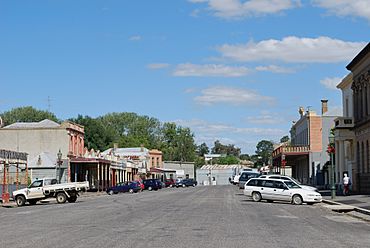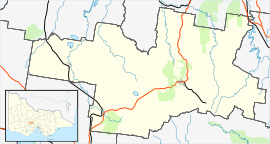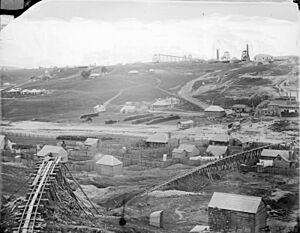Clunes, Victoria facts for kids
Quick facts for kids ClunesVictoria |
|||||||||
|---|---|---|---|---|---|---|---|---|---|

Main street of Clunes
|
|||||||||
| Population | 1,728 (2016 census) | ||||||||
| Established | mid-1850s | ||||||||
| Postcode(s) | 3370 | ||||||||
| Elevation | 310 m (1,017 ft) | ||||||||
| Location | |||||||||
| LGA(s) | Shire of Hepburn | ||||||||
| State electorate(s) | Ripon | ||||||||
| Federal Division(s) | Ballarat | ||||||||
|
|||||||||
Clunes is a small town in Victoria, Australia. It is about 36 kilometres north of Ballarat. In 2016, about 1,728 people lived there.
Clunes is famous for a few reasons. It was the first place in Victoria where gold was officially found in 1850. It also had a big gold miners' strike in 1873. Today, a campus of Wesley College is in Clunes. Parts of the movie Mad Max (1979) were filmed here. Other movies like "Ned Kelly" (2016) and the TV show "Bloom" (2018) also used Clunes as a filming location. Every year, the Clunes Booktown Festival brings many visitors to the town. It started in 2007 and has over 10 book shops.
Discovering Clunes: A Look at its Past
Early Days: The Dja Dja Wurrung People
Long ago, the land around Clunes was home to the Dja Dja Wurrung people. They are an Aboriginal Australian group. They were part of the larger Kulin nation. In 1836, a Scottish explorer named Thomas Mitchell explored this area. After Europeans started settling, many Dja Dja Wurrung people sadly died. This was due to new diseases and conflicts.
Mitchell likely told other Scottish people about the good land he found. One of them was Donald Cameron. In 1839, he started a large farm called a run. He named it Clunes after his hometown in Scotland. He built his main house there in the 1850s. Other Scottish farmers soon settled nearby.
Gold Rush and Growth
In March 1850, Donald Cameron and his friend William Campbell found small bits of gold on Cameron's farm. They kept it a secret at first. They worried that telling everyone would harm their farm.
In April 1851, a German scientist named George Hermann Bruhn visited Clunes. He was studying minerals in the Colony of Victoria. Cameron showed him the gold. Bruhn shared this news across Australia. He sent gold samples to the Gold Discovery Committee. After they confirmed it was gold, James Esmond and James Pugh found more gold in quartz rocks near Clunes on June 29. The Geelong Advertiser newspaper announced these findings in July.
William Campbell's announcement helped start the famous Victorian gold rush. A few years later, the town of Clunes was officially formed. The Port Phillip and Colonial Mining Company mined a lot of gold. This made the town grow very quickly. By the late 1880s, over 6,000 people lived in Clunes.
The Clunes post office opened in 1857. In 1874, Clunes got its own train station. It was connected to the Victorian railway network.
In 1873, the mine owners tried to make miners work on Saturday afternoons and Sundays. The miners refused and went on strike for three months. They formed the Clunes Miners' Association. They also stopped Chinese workers from Creswick from being used to break the strike.
Gold mining in Clunes ended in 1893. But for many years, Clunes was a very important gold town in Victoria. Today, the town has many beautiful old buildings. It is known as one of the best-preserved gold towns in Victoria.
Clunes in the 21st Century
Clunes: A Book Lover's Town
The idea to make Clunes a "booktown" like some in Europe came from local leaders. Clunes held its first "Booktown for a Day" event on May 20, 2007. Over 50 book sellers from all over Australia came. They set up their shops in the town's old buildings.
The event was later renamed the "Clunes Booktown Festival." It happens every year in March. The festival has won many awards. In 2012, Clunes was officially named an "International Book Town." This means it's recognized worldwide for its love of books.
Wesley College in Clunes
Between 2000 and 2008, Clunes changed a lot. This was because Wesley College, a large private school, decided to open a campus there. The campus opened in 2000 for Year 9 students.
About 80 students live in the Wesley Clunes Residential Learning Village each term. They stay for eight weeks. During this time, they become part of the local community. They learn how to live in a shared house and with others. This helps them prepare for growing up.
Sports in Clunes
Clunes has a local Australian rules football and netball team. They are called the Clunes Magpies. They play in the Central Highlands Football League.
If you like golf, you can play at the Clunes Golf Club. There is also a cricket club in Clunes. They play in the Maryborough District Cricket Association. Clunes also has a lawn bowls club. They compete in the Ballarat District Bowls Division.
Getting Around: Transport
Clunes railway station is on the Mildura line. At first, Clunes was not going to be part of a new train plan. But the town protested. So, in 2010, the government announced that Clunes station would reopen. It is now included on the line.
Clunes on the Big Screen
Clunes has been a popular spot for filming movies and TV shows.
- Many outdoor and some indoor scenes for the 2003 film Ned Kelly were filmed in Clunes. The Old State Bank was used for a bank robbery scene.
- Clunes also appears in the movie Mad Max with Mel Gibson. It was the town where the Toe Cutters gang arrived.
- The remake of the 1950s classic On the Beach also used Clunes.
- TV shows like Queen Kat, Carmel & St Jude, Something in the Air, and Halifax f.p. have filmed here.
- In 2001, Clunes was closed off for the TV show The Mole.
- Tomorrow, When the War Began aired on ABC3 in 2016.
- Part of the HBO show The Leftovers was filmed in Clunes.
- The 2018 remake of Picnic at Hanging Rock filmed scenes on the main street.
- The Stan series Bloom used Clunes as its main town.
- Some scenes for the movie True History of the Kelly Gang were filmed here.
- Julius Avery's short film Jerrycan was shot in Clunes. It won an award at the 2008 Cannes Film Festival.
Famous People from Clunes
Some notable people have lived in or were born in Clunes:
- Jean Beadle (1868–1942) – a leader for workers' rights and women's rights.
- Rivett Henry Bland (1811–1894) – managed the big gold mining company in Clunes.
- Nancy Jobson (1880–1964) – a headmistress.
- Robert (Bob) Lewis (1878–1947) – a famous jockey.
- Sir John Longstaff (1861–1941) – a well-known artist.
- Harley Tarrant (1860–1949) – a businessman.
- Daryl Jackson (born 1937) – a famous architect.
- Nick Hind (born 1994) – an AFL (Australian Rules Football) player.
Weather in Clunes
| Climate data for Clunes, elevation 332 m (1,089 ft) | |||||||||||||
|---|---|---|---|---|---|---|---|---|---|---|---|---|---|
| Month | Jan | Feb | Mar | Apr | May | Jun | Jul | Aug | Sep | Oct | Nov | Dec | Year |
| Record high °C (°F) | 43.3 (109.9) |
40.9 (105.6) |
36.8 (98.2) |
31.8 (89.2) |
24.9 (76.8) |
19.0 (66.2) |
20.7 (69.3) |
20.6 (69.1) |
27.0 (80.6) |
33.2 (91.8) |
36.1 (97.0) |
38.0 (100.4) |
43.3 (109.9) |
| Mean daily maximum °C (°F) | 28.5 (83.3) |
28.1 (82.6) |
24.7 (76.5) |
19.6 (67.3) |
15.1 (59.2) |
12.0 (53.6) |
11.2 (52.2) |
12.8 (55.0) |
15.6 (60.1) |
18.9 (66.0) |
22.7 (72.9) |
26.3 (79.3) |
19.6 (67.3) |
| Mean daily minimum °C (°F) | 10.8 (51.4) |
11.3 (52.3) |
9.3 (48.7) |
6.5 (43.7) |
4.2 (39.6) |
2.7 (36.9) |
2.0 (35.6) |
2.7 (36.9) |
3.9 (39.0) |
5.3 (41.5) |
7.3 (45.1) |
9.3 (48.7) |
6.3 (43.3) |
| Record low °C (°F) | −0.6 (30.9) |
3.9 (39.0) |
1.2 (34.2) |
−3.4 (25.9) |
−3.3 (26.1) |
−5.1 (22.8) |
−4.9 (23.2) |
−5.3 (22.5) |
−5.0 (23.0) |
−2.6 (27.3) |
−1.1 (30.0) |
1.7 (35.1) |
−5.3 (22.5) |
| Average rainfall mm (inches) | 34.1 (1.34) |
35.5 (1.40) |
33.5 (1.32) |
42.5 (1.67) |
54.5 (2.15) |
60.3 (2.37) |
59.0 (2.32) |
63.9 (2.52) |
56.2 (2.21) |
54.3 (2.14) |
45.7 (1.80) |
39.4 (1.55) |
578.7 (22.78) |
| Average rainy days (≥ 1.0 mm) | 3.5 | 3.1 | 3.9 | 5.5 | 7.6 | 9.3 | 10.1 | 10.6 | 9.0 | 7.8 | 5.8 | 4.8 | 81.0 |
| Source: Australian Bureau of Meteorology | |||||||||||||




